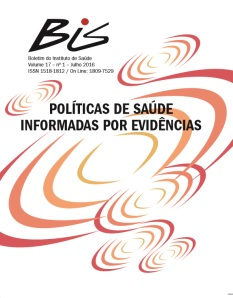Resumo
O Brasil ainda está longe de atingir uma das Metas do Milênio assumidas em 1990, de redução da mortalidade materna (MM). Atualmente, morrem no país cerca de 69 mulheres a cada 100 mil nascidos vivos, mas pelas metas da Organização das Nações Unidas esse número deveria ser de no máximo 35 mulheres. Nesse contexto, é possível ressaltar que as principais causas dessas mortes são a hipertensão arterial, hemorragia, complicações de aborto em condições inseguras e infecção pós-parto. Ademais, notam-se índices elevados de mortalidade materna no Brasil em regiões periféricas, onde o acesso às redes de saúde é quase inexistente e/ou precário. No município de Franco da Rocha, as altas taxas de MM vêm preocupando os gestores da saúde, especialmente por estarem relacionadas a causas consideradas evitáveis. Este artigo apresenta alguns resultados de uma Síntese de Evidências elaborada por alunas do Programa de Aprimoramento Profissional em Saúde Coletiva do Instituto de Saúde, com apoio do Núcleo de Evidências do Instituto de Saúde, o qual integra a Rede para Políticas Informadas por Evidências – EVIPNet Brasil, com o objetivo de apoiar a gestão municipal de saúde de Franco da Rocha na tomada de decisões para o enfrentamento da MM.
Referências
BMJ.2004;329(7475):1184.
2. Coimbra CL, Silva AMA, Mochel EG, Alves MTSSB, Ribeiro VS, Aragão VMF, et al. Fatores associados à inadequação do uso da assistência pré-natal.
Rev Saúde Pública. 2003;37:456-62.
3. Fournier P, Dumont A, Tourigny C, Dunkley G, Dramé S. Improved access to comprehensive emergency obstetric care and its effect on institutional
maternal mortality in rural Mali. Bull World Health Organ. 2009;87:30–38.
4. Goldie SJ, Sweet S, Carvalho N, Natchu UCM, Hu D. Alternative strategies to reduce maternal mortality in India: a cost-effectiveness analysis. PLoS
Med. 2010;7(4):e1000264.
5. Ivers N, Jamtvedt G, Flottorp S, Young JM, Odgaard-Jensen J, French SD, et al. Audit and feedback: effects on professional practice and health care
outcomes. The Cochrane Database of Systematic Reviews, 3, 2003.
6. Johnston G, Crombie IK, Davies HTO, Millard A. Reviewing audit: barriers and facilitating factors for effective clinical audit. Qual Health Care.
2000;9(1):23–36.
7. Jonas, E. Improving provider performance: an exploration of the literature, Box 3. Bolivia In-Service Training. Mother Care Matters.2000;9:10–1.
8. Kroeger M, Kaphagawani N, Kafulafula UK, Maluwa VM. Final evaluation of the malawi safe motherhood project life saving skills training
programme. Blantyre: DFID/Safe Motherhood Project. 2003.
9. McDermott J, Beck D, Buffington ST, Annas J, Supratikto G, Prenggono D, et al. Two models of in-service training to improve midwifery skills: how
well do they work? J Midwifery Womens Health. 2001;46:217–25.
10. Merkur S, Mladovsky P, Mossialos E, Mckee M. Policy brief. Do lifelong learning and revalidation ensure that physicians are fit to practise?
Copenhagen: WHO; 2008.
11. Ministère de la Santé Publique et de la Population. Normes et procédures cliniques des services de santé de la reproduction en République
Centrafricaine. Haiti; 2003. 84p.
12. Nyamtema AS, Urassa DP, Roosmalen JV. Maternal health interventions in resource limited countries: a systematic review of packages, impacts
and factors for change. BMC Pregnancy and Childbirth. 2011; 11:30.
13. O’rourke K. The effect of hospital staff training on management of obstetrical patients referred by traditional birth attendants. Int J Gynaecol
Obstet.1995;48(Suppl):S95-102.
14. Pattinson R, Kerber K, Waiswa P, Day LT, Mussell F, Asiruddin SK, et al. Perinatal mortality audit: counting, accountability, and overcoming
challenges in scaling up in low-and-middle-income countries. International Jornal of Gynaecology and Obstetrics.2009;107:113–21,121–2.
15. Pattinson RC, Say L, Makin JD, Bastos MH. Auditoría de acontecimientos críticos y retroalimentación (“feedback”) para disminuir la mortalidad y la
morbilidad perinatales y maternas (Revisión Cochrane traducida). Biblioteca Cochrane Plus. 2008;4.
16. Paxton A, Maine D, Freedman L, Fry D, Lobis S. The evidence for emergency obstetric care International Journal of Gynecology and Obstetrics.
2005; 88:181-193.
17. Prost A, Seward N, Azad K, Coomarasamy A, Copas A, Houweling TAJ, et al. Women’s groups practising participatory learning and action to
improve maternal and newborn health in low-resource settings: a systematic review and meta-analysis. Lancet.2013;381:1736–46.
18. Ronsmans C, Vanneste A, Chakraborty J, Van Ginneken J. Decline in maternal mortality in Matlab, Bangladesh: acautionary tale.
Lancet.1997;350:1810-4.
19. Sepou A, Serdouma E, Komas NP, Gody C, Abeye J, Koffi B, et al. Strategies for reducing maternal mortality in Central African Republic. Evidence-
Informed Policy Network (EVIPNet);2011.
20. Shea JB, Grimshaw JM, Wells GA, Boers M, Andersson N,Hamel C, et al. Development of AMSTAR: a measurement tool to assess the methodological
quality of systematic reviews. BMC Medical Research Methodology, London. 2007;7:10.
21. Sloan NL, Nguyen TN, Do TH, Quimby C, Winikoff B, Fassihian G. Effectiveness of lifesaving skills training and improving institutional emergency
obstetric care readiness in Lam Dong, Vietnam. J Midwifery Womens Health. 2005;50:315–2.
22. Thairu A, Schmidt K. Training and author is ingmid level providers in life saving skills in Kenya case study No 8. In: Crump S, editor. Shaping policy
for maternal and newborn health: a compendium of case studies. Baltimore, MD: JHPIEGO.2003.
23. Warren C, Liambila W. Safe motherhood demonstration project western province. approaches to providing quality maternal care in
Kenya. Nairobi: Population Council. 2004.
24. World Health Organization. Monitoring emergency obstetric care: a handbook. Geneva; 2009.
25. World Health Organization. Trends in maternal mortality: 1990 to 2008. Estimates developed by WHO, UNICEF, UNFPA and The World Bank.
Geneva; 2010. [acesso em 13 jun. 2015]. Disponível em: http://whqlibdoc.who.int/ publications/2010/9789241500265_eng.pdf
26. Woods DL. An innovative programme for training in maternal and newborn care. Seminars in Fetal & Neonatal. 1999;4(3):209-216.
27. Van Lonkhuijzen L, Dijkman A, Van Roosmalen J, Zeeman G, Scherpbier A. A systematic review of the effectiveness of training in emergency
obstetric care in low-resource environments. BJOG. 2010; 117(7):777-87.

Este trabalho está licenciado sob uma licença Creative Commons Attribution 4.0 International License.
Copyright (c) 2016 Carolina Médici de Figueiredo, Inayá da Silva Duarte, Luciana C. Alves do Santos, Luciana de Mendonça Freire, Tatiane Aparecida Rocha Marcelo, Sonia Isoyama Venancio
